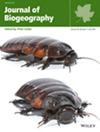Zoogeographical regions in the Atlantic Forest: patterns and potential drivers
Abstract
Aim
To delineate present-day zoogeographical regions of terrestrial vertebrates (frogs, lizards, snakes, birds and non-volant mammals) in the Atlantic Forest. Within each taxonomic group, we examine the relative importance of abrupt climatic transitions, orographic barriers, past climate change and rivers in shaping zoogeographical boundaries.
Location
South America's Atlantic Forest.
Methods
We applied a network-based method to delineate zoogeographical regions, using distribution data (range maps) for 455 species of frogs, 103 lizards, 220 snakes, 917 birds and 202 non-volant mammals, in 50 × 50 km grid cells. We used hierarchical generalized linear mixed-effects models to test environmental predictors associated with zoogeographical boundaries. Finally, we intersected the bioregion maps delineated for each group to identify general patterns across all vertebrates.
Results
We identified four zoogeographical regions for birds and snakes, and five for frogs, lizards and non-volant mammals. Depending on the group, contemporary and past climate conditions, elevation variation and/or rivers were associated with zoogeographical boundaries. The combined maps indicate that the Atlantic Forest retains four spatially cohesive zoogeographical regions based on present-day distribution of vertebrates.
Main conclusions
Cross-taxon congruence indicates that the geographical and environmental characteristics of the Atlantic Forest have a strong influence on the location of zoogeographical regions for vertebrates. In contrast, transition zones appear to be associated with the spatial distribution of life history traits of each group, potentially explaining the observed differences in the number of bioregions across groups and the position of zoogeographical boundaries. This work paves the way for further research into the evolutionary assembly of the Atlantic Forest's zoogeographical regions and may help inform conservation priorities for maintaining their distinctive faunas.

 求助内容:
求助内容: 应助结果提醒方式:
应助结果提醒方式:


